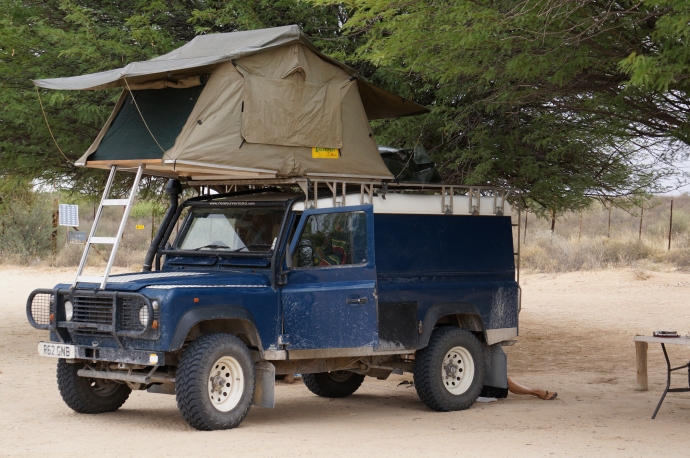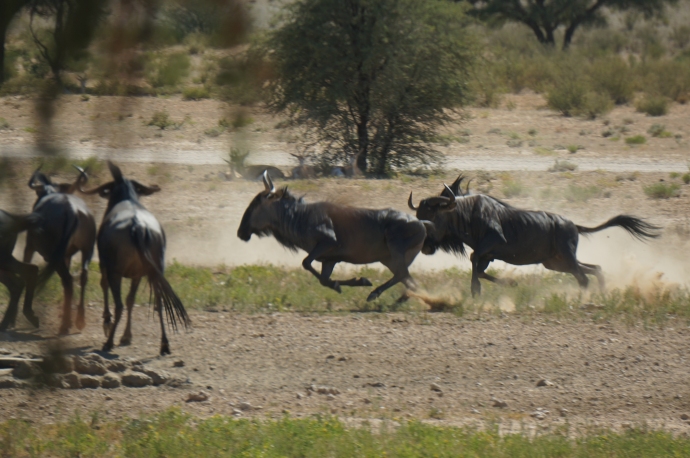Kruger National Park is a roughly rectangular splotch of land in the northeast quadrant of South Africa. It’s the largest of South Africa’s parks; its long axis, which runs northwest, is roughly five hundred kilometres long – slightly further than Vancouver to Penticton. On the east it borders Mozambique’s Limpopo National Park. In theory, the two parks will eventually be joined into the Great Limpopo Transfrontier Park. Negotiations are currently stalled, due in large part to South Africa’s concerns about poachers having increased access to Kruger through the proposed Mozambique gates. There would be some advantages, however; one articles on the topic notes that “the danger of lions becoming used to the taste of human flesh would be reduced . . . this has happened when illegal immigrants from Mozambique would slip through the security fence and fall prey to dangerous animals.” Most reassuring.
The road to Kruger was a narrow two-lane highway that wound through a dry landscape of reddish soil and withered trees. I had expected the area to be sparsely populated, but we seemed to be driving through the middle of a a single vast and sprawling village. The houses were scattered across the land with a pleasing randomness, as though each family had simply chosen a spot that looked good to them and set up their house there. (This is probably more or less what had happened).
A few of the houses looked like clay or mud daub, but most were breezeblock – a sensible choice, given the heat. We were driving with the windows and the windshield vents wide open, but the breeze was like the air that gusts out of a hot oven. The villagers did not seem to mind it as much as we did; the children roaming along the road were in full school uniform, and many had elected to pull on their sweatervests. They appeared cheerful enough, despite being dressed for a cool fall day. The thorny scrub that dominated the landscape provided little natural shade, but in places the locals had built small shelters of long crooked sticks, sometimes supplemented with an old tarpaulin or a sheet of torn netting.
The uniforms were one of numerous reminders that the region had once been a part of the British empire. The ‘Fish and Chips’ stencilled on a crumbling cement building was another, as was the ‘Tuck Shop’ sign pinned above a similarly dilapidated store.
After some hours the highway turned into a dirt road. We turned east, and the villages were replaced by an expanse of dust and golden grasses. The long flat line of the horizon, very far away, was broken only by the occasional acacia tree. This was the beginning of Kruger National Park.

Satara Rest Camp
We entered Kruger at the Satara gate, which is roughly one-third of the way up the park. After about ten minutes, we spotted a giraffe perhaps five metres from the road, casually wandering between some bushes. It paused for a moment and gazed at us unconcernedly before returning its attention to a cluster of thorns. People often describe giraffes as clumsy and ungainly. These people are mad. The proper word, I think, is unhurried; they walk as though they were moving through chest-high water.

Within the next eighty kilometres, we saw a lone steenbok (a type of antelope); countless impala (also a type of antelope); several warthogs (generally not considered antelope); wildebeests; a herd of big-horned Cape Buffalo stamping through a mud pit; and two more giraffes. There were also several clusters of zebras, which, despite being in their natural environment, still looked faintly comical. At one point we came across a lone zebra and Darren pulled out his camera to take a photo. We examined it on the digital screen. It was as perfectly bland as a photo of a zebra could be; the animal stood in the centre of the photo, staring back at us blankly, with nary a twitch of its tail. It was as if it didn’t even know that it had stripes.
“Kind of dull, isn’t it?” Darren commented, at which point the zebra walked a few steps forward to a dust patch, snorted, lay down, and then flung itself onto its back and writhed vigorously. It paused, looked at us, and did it again. Then it hauled itself back to its feet, shook its mane, gave us a contemptuous glance, and trotted away with a self-satisfied air.

When we returned from our first day driving we returned from driving around the park, we found that our flimsy gazebo had been blown away in the wind. Someone had found it and tied it to a tree near our original campsite. Another person had driven their caravan into our campsite and unfolded their own gazebo, guest tent, and portable washing-up stand in the area where we had been staying. We weren’t entirely sure what to do – my instinct, as a well-bred Canadian, was to slink away with our fold-up gazebo and find another spot, perhaps apologizing to those who had taken ours. After all, given that our tent had blown off, it might not have been entirely clear that the spot was taken. On the other hand, it was a prime location – right next to the perimeter fence, where spotted hyenas and the occasional lion prowl at night. And we had also left our chairs there, although again they may have appeared to belong to the neighbouring camp.
I think we still would have ended up doing nothing, or perhaps politely broaching the matter with the intruders, but two of our neighbours from the previous night came marching up to as as we were discussing the matter.
“Can you believe the nerve?” one of them, a middle-aged man, said. “Taking your spot! I tell you what you should do. You should just go to the camp staff and tell them. Tell them that you were in this place and left some things here and that another camper came and set up while you were away during the day. That’s how it’s done here. Don’t even get involved. Let the camp staff manage it. We’ll be witnesses. You were here first!” And the other neighbour somehow managed to simultaneously nod his head in sympathetic agreement and shake it in disgust at the transgressors.
So, figuring that these seasoned South African campers were more in tune with the local culture than we were, we walked down the the reception area and explained the situation. The manager sent two men back with us. Both were friendly, but hadn’t explained what they usually did in situations like this; they didn’t scoff at us, which I had half expected, but nor did they pull out their batons and begin tapping them against their legs menacingly.
Two people came out of the caravan when we approached it: a tall man and a shorter woman, both with sun-weathered complexions. The camp staff outlined the situation while we fidgeted, both of realizing that, in retrospect, it would have been better to have approached them directly.
“There’s no problem here,” the man said adamantly. I initially interpreted his manner as confrontational, but soon realized that it was not so.
“Look,” he continued, “this is what happened: We found these folks’ gazebo, yes? And it had blown away, yes? So we went and we tied it up. It was over in that tree over there. We didn’t know they were camped here, so were camped here. ” All this was said with a strong South African accent. Next he turned to us.
“Where are you from? Canada? Well, there’s plenty of room, ja?” Then back to the camp staff: “They can camp there and we’ll braai with them tonight.” Then back to us: “That’s how we do things in South Africa. We want you to know that South Africans are friendly. So we’ll be neighbours and tonight we will have you over for a braai. There is no problem here!”
This was all very awkward. The camp staff were smiling and nodding and we were attempting to graciously accept while also somehow conveying that we hadn’t been wholly convinced that this intervention was a good idea to begin with, but had been swayed by the urgings of his South African compatriots.
The situation had a happy resolution. We had a very pleasant evening with the couple, who turned out to be corn and sheep farmers from central South Africa. The man started a fire with dried corn cobs from their farm and grilled masses of sheep ribs and boerewoers, which Darren assures me were excellent. His wife brought me into their caravan’s kitchen and demonstrated how the make pap. This is similar to semolina (some know the instant version as Cream of Wheat), but is made with maize meal and stiffened to the approximate consistency of mashed potatoes. Pap is historically the staple food of poor South Africans, but has acquired some popularity among the general populace. Some restaurants serve it with curry as an alternative to rice. So all was well.

Driving North
There is one paved road running from the southern to the northern end of the park. Feeding into the road are many looping dirt roads in various states of repair. We drove north along these roads, marvelling at various things and hoping (in vain, alas) to happen across a pride of lions lolling in the sun. We did see a wide variety of other animals, including baboons, a Goliath Heron (large, but less fearsome than it sounds), some hippos, crocodiles (which look disappointingly similar to logs), and a bushy-tailed spring hare.

The most common animals were impala, small herds of which roam the entirety of Kruger, and spotted hyenas, which come out when the park visitors start cooking over their fires.
Impalas look as though someone took one of our deer to a top designer and asked them to develope a fresher, sleeker model with high curb appeal. The impala’s coat is russet where it covers its back and cream across its sides and underbelly, with a clean line separating the colours. Black markings across their hindquarters and foreheads add panache. They have a light, elegant bone structure, a solemn gaze, and a bounding stride. The males have long, spiralling horns, regularly sharpened against trees.

Hyenas, on the other hand, look like the discarded clay models of an art school reject. They are bizarrely disproportionate; their heads are lumpish and too large for their necks, which in turn are too large for their bodies. Their spine slopes sharply down to their back legs, like that of an overbred German shepherd. They padded clumsily along the perimeter fence of the campground at night, grinning slavishly, lunging at the bones that were occasionally tossed their way.

The larger mammals became scarcer, and the birds more abundant, as we went north.


Darren took many other fine photos, which can be seen here.



















































